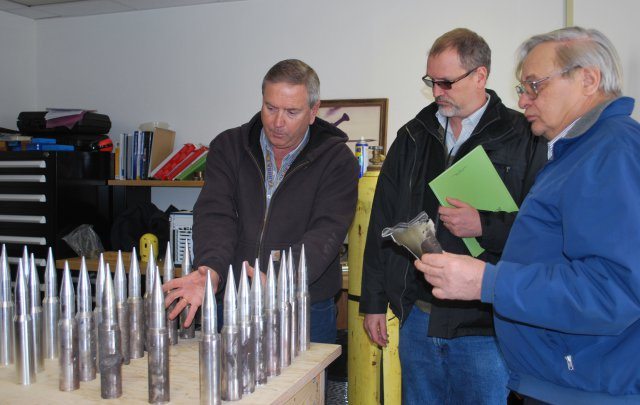In order to protect Soldiers’ lives, military vehicles in combat must be capable of surviving severe hostile fires. When hit with large hostile fire weapons, internally stowed ammunition may react resulting in catastrophic loss of life and system.
The U.S. Army Research Laboratory, or ARL, then the Ballistics Research Laboratory, or BRL, developed effective ammunition compartments in the past, to include the development of the Abrams bustle compartment back in the 1980’s. This success was achieved primarily through extensive test and evaluation.
As the Army modernizes its fleet, effective ammunition compartmentation will again be needed to ensure vehicles and crew members survive hostile fires. Given technology advances, ARL has the opportunity to employ advanced modeling and simulation techniques to reduce test quantities and arrive at effective designs with fewer design iterations.
Greg Mannix, ARL’s technical project lead, is developing modeling and simulation methodologies to improve the survivability of combat fighting vehicles beginning with hypotheses synthesis and phenomenology studies underpinned by experimentation.
“The threat warhead to stowed ammo interaction is very complex, we have decomposed the ballistic interaction into a set of possibilities to guide our research,” said Mannix. “This approach defines the framework for our research allowing us to diagnose the energetic responses, draw correlations among critical parameters and ultimately develop the model architecture.”
Jerry Watson and Thomas Adkins, both from the Survivability/Lethality Analysis Directorate, also known as SLAD, have been performing experiments and gaining critical insights to the ammunition interaction.
“By doing experiments where the parameters are easily controlled, engineering algorithms are being developed that will predict the results for real-world situations where the area of interest is very complicated and too costly to evaluate experimentally,” said Watson.
Mannix expands on Watson’s contributions.
“Jerry designed and fabricated the ‘Watson Scaled Ammo Compartment Test Rig’ for the purpose of exploring the energetic response. In doing so, he brings a new experimental capability to Aberdeen Proving Ground, Maryland. I’m grateful to all he has contributed,” said Mannix.
Barrie Homan, Ph.D., and Douglas Kooker, Ph.D., both with the Weapons and Material Research Directorate, or WMRD, have been exploring the physics of the interaction between threat and energetic material contained within the munition by using material equations-of-state models to describe parameter dependencies. The synergies realized in the coupling of hypotheses, experimentation, and physics enable the development of an ammunition compartment model and simulation methodologies to improve combat vehicle survivability.
“The consequences arising from a ballistic threat interaction with munitions are fundamentally related to the energetic material response behavior. The response is complex and a full understanding of the phenomena continues to be elusive,” said Homan. “A multidisciplinary approach coupling phenomenological experimental results and controlled surrogate experiments with advanced model development are our best approach to develop the ability to predict responses in real systems.”
Mannix indicated their testing is having a significant impact, and the Army is already benefiting from the knowledge received to date from the ammunition compartment test.
“ARL’s ammunition compartmentation research has already had an impact on the larger [test and evaluation] community. As the research team extracts meaningful information from the experiments, the [ground combat vehicle] program is benefiting, as [Army Test and Evaluation Command] leverages ARL’s early experimental results to determine Live-Fire Test asset quantities and test events for the GCV program,” said Dave Ploskonka, Army Test and Evaluation Command.
This work and related ARL contributions to design of compartmentation systems are also being leveraged by the U.S. Army Tank Automotive Research, Development and Engineering Center in the development of their ground vehicle concepts.
Today, the research team moves forward exploring the unknown, learning a lot on this complex threat-target interaction, and developing model methodology to provide for the world’s most survivable combat vehicle for U.S. Soldiers.










